Time Spent on Unpaid Domestic and Caregiving Services – Are today’s policies reducing women’s ‘Time Poverty’
Introduction
The National Statistical Office (NSO) has recently published the findings of the Time Use Survey (TUS) 2024, providing a detailed snapshot of how people across India distribute their daily 1,440 minutes among paid work, unpaid tasks, and personal activities. As a vital statistical instrument, the survey offers crucial data on the utilization of the workforce while shedding light on gender inequalities and broader social trends. Time Use Surveys are increasingly recognized worldwide for their ability to evaluate work-life balance, particularly from a gender-sensitive perspective.
In addition to its national overview, the survey distinguishes between urban and rural populations, highlighting how geographical and state-level contexts shape daily routines. These differences serve as valuable inputs for policy-makers and researchers aiming to understand and address socio-economic disparities across regions. Globally, harmonized Time Use Surveys have played a key role in advancing gender research. Studies in Europe, such as Moreno (2017), have demonstrated how such data reveal differences in how men and women engage with work, leisure, and caregiving—an approach now reflected in India’s growing use of time-use data for social analysis.
Studies on unpaid care work distribution among household members could be extraordinarily difficult without knowing how people allocate their time to such duties. The need for data on time use is therefore of utmost importance. In recent years, time-use surveys and statistics have gained importance among policymakers for their usefulness in measuring dimensions of gender equality and human well-being. Time-use surveys can highlight the unequal distribution of unpaid work between women and men, as well as help to understand the contribution of unpaid work to the national economy. When the data collected is analyzed as evidence, it opens up policy dialogues towards a fair distribution of household and care-related tasks between women and men.
Executive Summary
The 2024 Time Use Survey (TUS) confirms with data what has long been understood intuitively: women’s unpaid care work is the backbone of the nation, often coming at the expense of their own goals and ambitions. Acknowledging this reality is no longer enough—policy action must follow.
The Time Use Surveys conducted by the Ministry of Statistics and Programme Implementation in 2019 and 2024 offer critical insights into how unpaid care work is divided between men and women in India. A comparison of the two surveys reveals enduring gender inequalities, accompanied by some notable changes over the five-year period.
Unpaid Domestic Work: A Persistent Gender Gap
In 2019, women in India spent an average of 299 minutes each day on unpaid domestic services for household members—over three times more than men, who contributed just 97 minutes. By 2024, women’s daily time dropped slightly to 289 minutes, but men’s participation declined to 88 minutes. Despite growing awareness, the burden of domestic work continues to fall overwhelmingly on women, with minimal progress toward equity.
Unpaid Caregiving: An Increasingly Unequal Load
The 2019 data showed women spending 134 minutes daily on unpaid caregiving, compared to 76 minutes for men. Five years later, women’s caregiving time increased to 137 minutes, while men’s caregiving time declined to 75 minutes. This growing imbalance is a stark reminder that caregiving remains largely invisible and unsupported, with women bearing the brunt.
Participation in Unpaid Work: Women Carry the Weight
Women’s participation in unpaid domestic work remained alarmingly high—rising from 81.2% in 2019 to 83.9% in 2024. Men’s involvement, although improved, remained far lower, increasing from 26.1% to just 45.8%. In caregiving, only 21.4% of men participated in 2024, compared to 41% of women. These numbers reflect a persistent structural inequality that demands not just recognition, but also decisive policy action.
How do Indians spend their day?
Distribution of 24 hours in a day over different activities. The following three charts give the percentage of time spent in a day in different activities for a person aged 6 years and above.
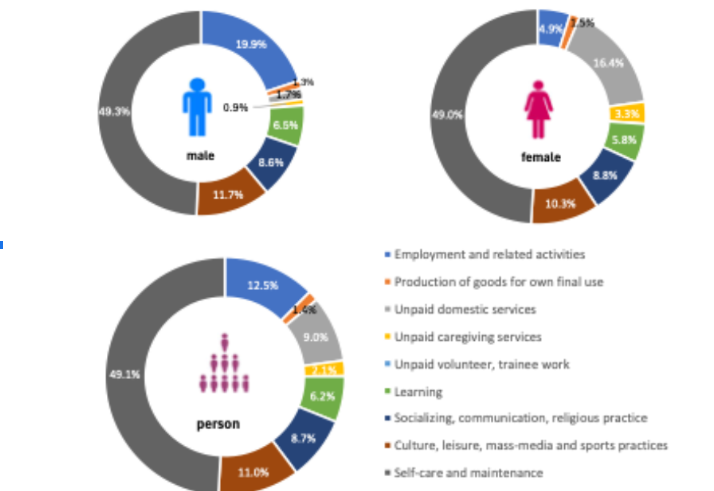
Figure 1: How Indians spend their 24 hours every day.
2024 data analysis examines how time is distributed across various daily activities by gender, revealing notable disparities in the way men and women allocate their time to work, unpaid labor, personal care, and leisure. Men dedicate significantly more time (19.9%) to employment-related activities than women (4.9%). In contrast, women assume a far greater share of unpaid domestic responsibilities—spending 16.4% of their time on household services compared to just 1.7% for men. Similarly, women devote 3.3% of their time to unpaid caregiving, more than three times that of men (0.9%). In the realm of education, men spend slightly more time learning (6.5%) than women (5.8%), although the difference is relatively small. When it comes to social and cultural engagement, both genders spend a similar amount of time socializing, with women at 8.8% and men at 8.6%. However, men engage more in cultural activities such as entertainment and hobbies (11.7%) than women (10.3%). Overall, the data underscores persistent gender-based imbalances—women bear a disproportionate burden of unpaid domestic and caregiving labor, while men dominate in paid employment and leisure-related pursuits.
Participating and time spent by women and men by activity for the employable population (15-59 years)
| Participation rate (15-59 years) | ||||
| 2019 | 2024 | |||
| Male | Female | Male | Female | |
| Employment & related activities | 70.9% | 21.8% | 75% | 25% |
| Unpaid Domestic Services | 28.9% | 92.3% | 30.4% | 92.9% |
| Unpaid Caregiving | 16.2% | 32.8% | 21.4% | 41% |
| Average Time Spent in minutes per participant (15-59 years) | ||||
| 2019 | 2024 | |||
| Male | Female | Male | Female | |
| Employment & related activities | 463 | 328 | 477 | 338 |
| Unpaid Domestic Services | 94 | 291 | 87 | 280 |
| Unpaid Caregiving | 75 | 154 | 77 | 164 |
| Average Time Spent in minutes per person (15-59 years) | ||||
| 2019 | 2024 | |||
| Male | Female | Male | Female | |
| Employment & related activities | 333 | 75 | 360 | 86 |
| Unpaid Domestic Services | 28 | 290 | 26 | 283 |
| Unpaid Caregiving | 12 | 45 | 16 | 58 |
(Source: Time Use Survey 2024)
The comparison of time-use data between 2019 and 2024 for individuals aged 15–59 highlights persistent and evolving gender disparities in both participation rates and average time spent across employment, unpaid domestic services, and unpaid caregiving.
Employment and Related Activities:
Men’s participation in employment increased from 70.9% in 2019 to 75% in 2024, while women’s participation rose modestly from 21.8% to 25%, indicating a marginal narrowing of the gender gap. In terms of time spent, men increased their average from 463 to 477 minutes, and women from 328 to 338 minutes. While both participation and time spent have improved for women, the gap remains substantial, reflecting ongoing barriers to equal labor market access.
Unpaid Domestic Services:
Women continue to bear the overwhelming burden of unpaid domestic work. Participation for women rose slightly from 92.3% to 92.9%, while for men it increased from 28.9% to 30.4%, indicating minimal change in traditional gender roles. Interestingly, while participation increased, the average time spent by both genders decreased slightly—women from 291 to 280 minutes, and men from 94 to 87 minutes—suggesting possible improvements in efficiency, shared responsibility, or access to services.
Unpaid Caregiving:
This category saw the most notable change in female participation, rising from 32.8% to 41%. Male participation also increased, from 16.2% to 21.4%. Despite this progress, women still account for a much higher share of caregiving. The average time spent by women rose from 154 to 164 minutes, while men showed only a modest increase (75 to 77 minutes), underlining the growing caregiving load on women, potentially due to demographic shifts or insufficient formal care.
The data suggests incremental progress in women’s participation in paid work and a slight increase in male engagement in unpaid care work. However, women continue to shoulder a disproportionate share of unpaid responsibilities, which limits their time for employment and skill development. To accelerate gender parity, policy focus must shift toward redistributing unpaid work, investing in care infrastructure, and enabling women’s full economic participation.
Furthermore, a breakdown of domestic and care work, when available, shows that there is a gendered division of labor within the household. For example, women are responsible for daily food and household management, including food preparation, cleaning, and physical care of children. In contrast, men mainly participate in shopping for the household, traveling for household upkeep, teaching children, and accompanying children to places.
The data from both surveys underscore the enduring gender imbalance in unpaid domestic work in India. Over the past five years, there has been little shift in how women in India allocate their time. Despite a significant rise in female labor force participation—from 24.5% in 2018-19 to 41.7% in 2023-24, according to annual labor force surveys —the time women dedicate to paid work has increased by just six minutes, from 56 minutes per day in 2019 to 62 minutes in 2024. Although this marks progress, the gap remains wide, highlighting the need for greater opportunities for women in the workforce.
This unpaid labor includes cooking, cleaning, childcare, eldercare, and other forms of support that keep households—and by extension, economies—functioning. While these responsibilities are vital, they are not formally recognized or remunerated, resulting in the systemic undervaluation of women’s work.
Participating and time spent by women and men in unpaid domestic and caregiving services by education levels: Does higher education have an impact on women’s time spent on unpaid domestic and care work?
Women and girls today have better educational opportunities, health outcomes, and political representation than ever before.
But for many, those advances have not translated into a proportionate improvement in economic opportunity or agency over their lives (Ferrant et al., 2014; Heintz, 2018). However, the analysis of the TUS survey shows mixed results.
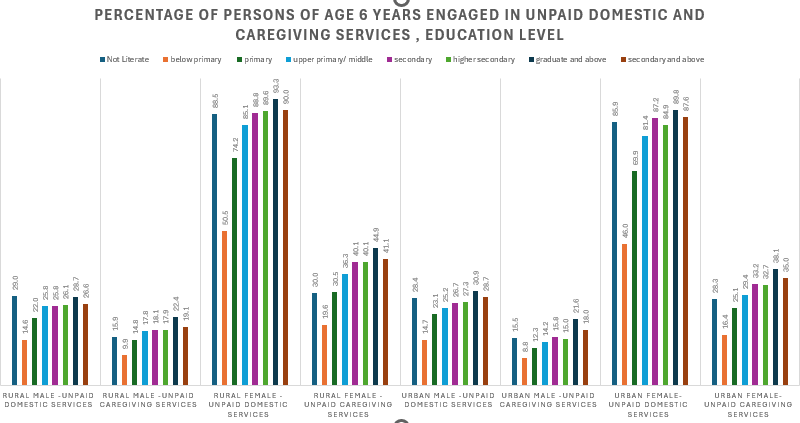
(TUS 2024)
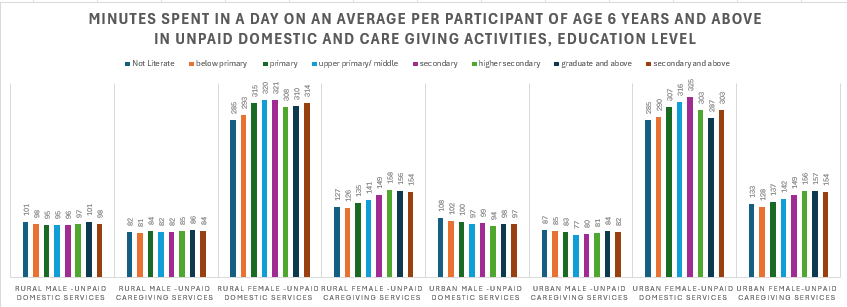
(TUS 2024)
As education increases, the time spent by both men and women declines slightly, but the disparity remains pronounced. For those with graduate-level education and above, rural females still spend 207% more time than rural males on domestic work (310 vs. 101 minutes), and urban females spend 193% more than urban males (287 vs. 98 minutes). In unpaid caregiving, the pattern is similar, but the percentage gaps are somewhat smaller. For example, at the secondary level, rural females spend 149 minutes compared to 82 minutes by rural males—a difference of 82%. In urban areas at the same education level, females spend 149 minutes versus 80 minutes by males, an 86% increase. Overall, higher education does not eliminate the gender gap in unpaid labor, indicating deep-rooted social norms that persist regardless of educational attainment.
While more women are earning, they still carry the weight of unpaid work. 25% of women aged 15-59 years are now employed, up from 21.8% in 2019; however, women still spend 305 minutes on unpaid domestic work and men just 86 minutes. Almost all (92.9%) of the women surveyed in this category are engaged in domestic work, while less than one-third (30.4%) of the men engage in any sort of domestic activities.
Participating and time spent by women and men in unpaid domestic and caregiving services by marital status: Time poverty and motherhood Penalty
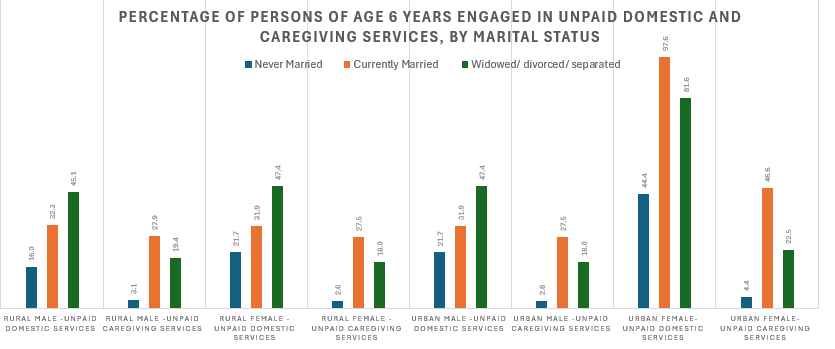
(TUS 2024)
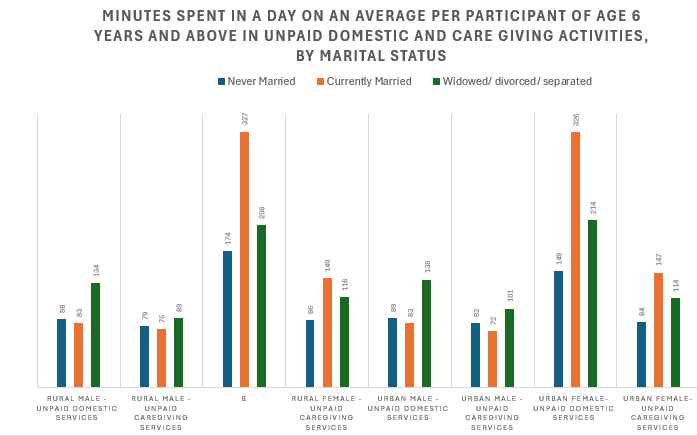
(TUS 2024)
Across all marital statuses, women consistently spend more time than men on these tasks, but the disparity is most pronounced among those who are currently married. Currently, married females spend up to 294% more time on unpaid domestic services than their male counterparts in both rural (327 vs. 83 minutes) and urban (326 vs. 83 minutes) settings. In terms of unpaid caregiving, currently married females also spend significantly more time—87% more in rural areas (140 vs. 75 minutes) and 104% more in urban areas (147 vs. 72 minutes). Among the never-married, the gender gap narrows but remains substantial, with women spending 98% (in rural areas) and 67% (in urban areas) more time on domestic services than men. Interestingly, the difference in caregiving time among the never-married is minimal in urban areas (only a 2% gap). Among widowed/divorced/separated individuals, females still spend more time than males on unpaid work, but the differences tend to be less extreme than among the currently married. Overall, marital status, particularly being presently married, is strongly associated with a greater gender imbalance in unpaid domestic and caregiving labor.
Men’s contribution in the household work significantly declines post-marriage, while that of women sees a dramatic rise after getting married. This pattern reflects entrenched gender roles, where household responsibilities disproportionately shift to women post-marriage. This reinforces the traditional role of women as primary caregivers.
A 2018 Oxfam report states that the unpaid work done by women effectively subsidizes the economy, although it is often not recognized or valued in monetary terms within traditional economic frameworks. The work women do at home supports the workforce (including the men who are part of it) without any direct financial compensation or recognition in national economic indicators. This scenario is often described as ‘Time Poverty’ or ‘Motherhood penalty’, referring to the disproportionate amount of time married women and mothers are required to spend on unpaid work, which is not demanded of men to the same extent.
Participating and time spent by women and men in unpaid domestic and caregiving services by location:
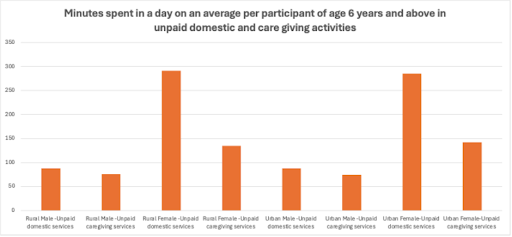
(TUS 2024)
Generally speaking, having access to safe drinking water, electricity, and gas for cooking and heating, or having time-saving assets such as a cooking stove, is likely to reduce time spent on unpaid work for collecting water and fuelwood.
Simply being a woman is the most significant factor affecting the amount of unpaid domestic and care work responsibilities. Married women with small children tend to bear much of the unpaid domestic and care work burden. Other factors include low income level and living in rural populations. Rural populations in general spend longer hours on unpaid domestic and care work than urban populations. This is due to both supply and demand constraints. On the supply side, the absence of, or limited availability of, services such as child care facilities, electricity, safe drinking water, energy, and affordable public transportation in rural areas affects how people spend their time. On the demand side, many in rural areas are also income poor. Those who engage in subsistence farming do not have much cash to pay for services, even if the public services are available in their communities. Without electricity, piped water, or fuels, for example, household chores such as food preparation, processing, and washing clothes take more time.
In rural areas, women spend 231% more time than men on unpaid domestic services (291 vs. 88 minutes), while in urban areas the gap is 224% (285 vs. 88 minutes). For unpaid caregiving services, rural females spend 78% more time than rural males (135 vs. 76 minutes), whereas urban females spend 92% more time than urban males (142 vs. 74 minutes). This indicates that while the overall burden of unpaid work is high for women regardless of location, urban women spend marginally more time on caregiving relative to their male counterparts compared to rural women. However, rural women continue to bear a slightly higher load in domestic tasks. The consistent disparity highlights that location has limited impact on reducing gender imbalances in unpaid labor, and social expectations continue to place a disproportionate burden on women.
Implications
The data from both surveys highlight the persistent gender disparity in unpaid care work in India. Despite marginal increases in men’s participation and slight reductions in the time women devote to these tasks, women continue to shoulder a disproportionate share of the burden. This imbalance significantly affects women’s economic participation, social mobility, and overall well-being. To address these challenges, policy efforts must focus on redistributing unpaid care responsibilities more equitably between genders. Key strategies include encouraging shared domestic responsibilities, expanding public services and caregiver support, and enacting gender-responsive labor policies that acknowledge care-related constraints.
Neglecting the impact of unpaid domestic and caregiving work on children, particularly adolescent girls, carries long-term consequences. These responsibilities can limit their ability to pursue education and hinder their smooth transition into the labor market. Recognizing the unpaid work performed by adolescents is essential for understanding the hidden barriers to girls’ development and ensuring their rights to education, health, and personal growth are not compromised.
Conclusion
Nations across the world already provide services that meet basic human needs, such as primary education and medical care, but more can be done towards the achievement of sustainable development. Often, public and private services provided by professionals in education or in the care of the sick, elderly, and people with disabilities offer better quality than services provided at home. Moreover, public investment for better access to irrigation, water purification, electricity, and modern energy for cooking or heating can reduce time spent on unpaid work and improve people’s health outcomes. If people are the real wealth of a nation (UNDP, 2016), nations need to make sure such services are available to all households, at free of charge or at an affordable price.
The persistent gender disparity in unpaid care work, as evidenced by recent time-use data, has far-reaching implications for women’s economic participation, skill development, and overall well-being. Despite some progress, including marginal increases in male contributions and minor reductions in women’s time spent on unpaid work, the burden remains disproportionately shouldered by women. This imbalance is deeply rooted in prevailing gender norms and the lack of supportive infrastructure, and it continues to limit women’s ability to engage fully in productive and paid employment.
A strategic response to this issue must go beyond surface-level adjustments and focus on systemic change. Policymakers, businesses, and civil society actors should consider coordinated action in five critical areas:
- Enhance Female Labor Force Participation by Addressing Unpaid Care Work: Prioritizing policies that redistribute and reduce unpaid care responsibilities is essential. Investments in quality public services—such as childcare, eldercare, health care, and education—can alleviate the domestic workload disproportionately borne by women. Additionally, improving access to basic infrastructure, such as clean water, electricity, and cooking fuel, can reduce time poverty and enable greater participation in paid work.
- Tackle Women’s Underrepresentation in Leadership: Gender disparities in unpaid work contribute to limited career advancement and leadership opportunities for women. Addressing these disparities through supportive workplace policies—such as flexible work hours, parental leave for both genders, and caregiving support—can create pathways for women to assume leadership roles across sectors.
- Expand Access to Digital Technology: Bridging the digital divide is essential for empowering women economically and socially. Access to digital tools and skills enhances opportunities for remote work, education, financial inclusion, and entrepreneurial ventures, particularly for women who are constrained by unpaid care responsibilities.
- Transform Social Norms Around Gender Roles: Time-use data reveals entrenched social conditioning in how men and women allocate their time. Public campaigns, education reforms, and engagement with communities are needed to challenge and shift these attitudes, promoting a more equitable division of labor within households and society.
- Promote Regional Collaboration for Gender Equality: Unpaid care work and gender inequality are not confined to national borders. Regional alliances and policy harmonization can accelerate progress, allowing countries to share best practices, pool resources, and collectively address structural gender disparities.
The recognition of unpaid care work as a key driver of inequality and a barrier to economic development is critical. A multidimensional policy approach—grounded in time-use data and informed by regional cooperation—can lay the foundation for inclusive growth and sustainable development. Without addressing the care economy and the social norms that shape it, gender equality and broader development goals will remain out of reach.
The views and opinions expressed here belong solely to the author and do not reflect the views of BlueKraft Digital Foundation.







